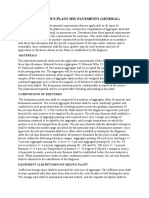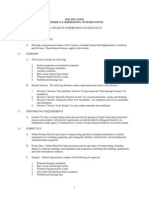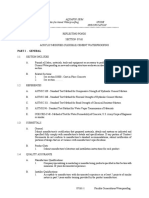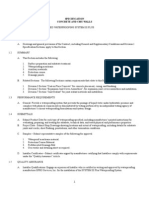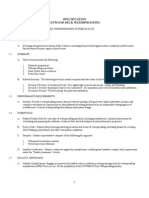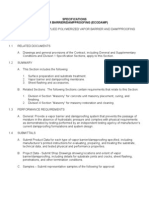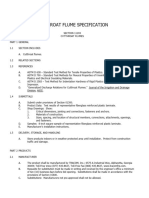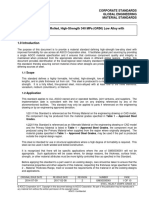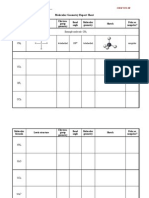1.1 A. 1.2 A. B. C. 1.3 A. B. C. D. E. F. G. H. I.: Click Here
1.1 A. 1.2 A. B. C. 1.3 A. B. C. D. E. F. G. H. I.: Click Here
Uploaded by
Riksa AsCopyright:
Available Formats
1.1 A. 1.2 A. B. C. 1.3 A. B. C. D. E. F. G. H. I.: Click Here
1.1 A. 1.2 A. B. C. 1.3 A. B. C. D. E. F. G. H. I.: Click Here
Uploaded by
Riksa AsOriginal Title
Copyright
Available Formats
Share this document
Did you find this document useful?
Is this content inappropriate?
Copyright:
Available Formats
1.1 A. 1.2 A. B. C. 1.3 A. B. C. D. E. F. G. H. I.: Click Here
1.1 A. 1.2 A. B. C. 1.3 A. B. C. D. E. F. G. H. I.: Click Here
Uploaded by
Riksa AsCopyright:
Available Formats
SECTION 02341 LIGHTWEIGHT, GEO-SYNTHETIC FILL
Display hidden notes to specifier. (Don't know how? Click Here) Copyright 2010 - 2013 ARCAT, Inc. - All rights reserved
PART 1 1.1
GENERAL
SECTION INCLUDES
A. 1.2
Lightweight, Geo-Synthetic Fill.
RELATED SECTIONS
A. B. C. 1.3
Section 02230 - Site Clearing: Clearing and grubbing of site. Section 02240 Dewatering: Dewatering as required. Section 02315 - Excavation and Fill: Excavation, preparation of, subgrade, sand drainage blanket, backfilling and compaction.
REFERENCES
A. B. C. D. E. F. G. H. I.
ASTM C 165 - Test Method for Measuring Compressive Properties of Thermal Insulation ASTM C 203 - Breaking Load and Flexural Properties of Block-Type Thermal Insulation ASTM C 303 - Test Method for Dimensions and Density of Preformed Block an Board-Type Thermal Insulation ASTM C 390 - Practice for Sampling and Acceptance of Thermal Insulation lots ASTM D 1621 - Compressive Properties of Rigid Cellular Plastics ASTM D 1622 - Apparent Density of Rigid Cellular Plastics ASTM D 1623 - Tensile and Tensile Adhesion Properties of Rigid Cellular Plastics ASTM C 2863 - Test Method for Measuring the Minimum Oxygen Concentration to Support Candle-Like Combustion of Plastics (Oxygen Index) ASTM D 6817 - Specification for Rigid Cellular Polystyrene Geofoam
02341-1
J. 1.4
ASTM D 7557 - Standard Practice for Sampling of Expanded Polystyrene Geofoam Specimens.
UNIT PRICE - MEASUREMENT AND PAYMENT
A.
Lightweight, Geo-Synthetic Fill. 1. Basis of Measurement: By cubic yard (cubic meter). 2. Basis of Payment: Includes supplying fill materials, stockpiling, placing and anchoring.
1.5
SUBMITTALS
A. B.
Submit under provisions of Section 01300.
1. 2. 3. C. 1. 2. 3. 4. 5. D. E.
Product Data: Manufacturer's data sheets on each product to be used, including: Preparation instructions and recommendations. Storage and handling requirements and recommendations. Installation methods. Shop Drawings: Showing the following: Profile and section view of the proposed embankment. Size, type, location and orientation of all Geofoam blocks. Location and type of connectors. Ballasting or guying techniques. Placement sequence and methods.
Verification Samples: For each product specified, two samples, minimum size 4 inches (102 mm) square, representing actual product. Manufacturer's Certificates: Certify products meet or exceed the following: 1. Manufacturer's test reports showing the physical properties and standards for the products specified as tested in accordance with ASTM D 7557. 2. Manufacturer's Certificate of Compliance for the first 100 yd (376 m3) and for every 1500 yd3 (1147 m3) thereafter of Geofoam before product is delivered to the site. 3. Computer generated stress-strain data and the accompanying curves from compressive testing. Curves and/or data shall clearly indicate the stress at 1 percent strain and the modulus of elasticity. 4. Each delivery shall have the compression test data for each lot attached with the delivery paperwork. 5. Certificate of Compliance shall include current inspection reports showing that the Geofoam manufacturer is in compliance with a UL follow-up service program for both flame and physical properties.
1.6
QUALITY ASSURANCE
A.
Manufacturer Qualifications: Manufacturer with a minimum of 5 years documented experience in the manufacture of lightweight, geo-synthetic fill. Manufacturer must also have a UL classification in category BRYX. Manufacturer must also maintain a UL classification in category QORW that ensures physical properties in accordance with ASTM D 6817. Third-party certifications that only include ASTM C 578 physical properties will not be considered as an alternative equal and will be rejected.
02341-2
1.7
DELIVERY, STORAGE, AND HANDLING
A. B. C.
Handle and store products in accordance the manufacturer's recommendations until ready for installation. Prevent damage to the Geofoam blocks during delivery, storage, and construction. Geo-Synthetic Fill that is anticipated to be exposed to sunlight for more than six months shall be covered with an opaque material to prevent ultraviolet light degradation. Remove material that is exposed for excessive period beyond six months. Protect the Geo-Synthetic Fill from: organic solvents such as acetone, benzene, and paint thinner; petroleum based solvents such as gasoline and diesel fuel; and open flames. Geo-Synthetic Fill should be considered combustible and should not be exposed to open flame or any source of ignition.
D.
E. 1.8
SEQUENCING
A.
Ensure that placement drawings and other information required for installation of products of this section are furnished to affected trades in time to prevent interruption of construction progress. PRODUCTS
PART 2 2.1
MANUFACTURERS
A.
Acceptable Manufacturer: Insulfoam, a Carlisle Company, which is located at: 6004 N. Westgate Blvd. Suite 120 ; Tacoma, WA 98406; Toll Free Tel: 800-248-5995; Tel: 253-572-5111; Fax: 425-251-8405; Email: request info (info@insulfoam.com); Web: www.insulfoam.com Requests for substitutions will be considered in accordance with provisions of Section 01600.
B. 2.2
MATERIALS
A.
Geo-Synthetic Fill: InsulFoam GF shall conform to ASTM D 6817 and may be fabricated using material with recycled content. Blocks shall have a height of at least 36 inches (.91 m), a width of at least 48 inches (1.22 m), and length of at least 96 inches (2.44 m). Blocks shall be within tolerances of 0.5 percent of respective height, width and length dimensions. Additional field and/or shop trimming and cutting shall be required as necessitated by the geometry of the fill being constructed. 1. Type EPS12: Physical Properties shall be as follows: a. Density shall be a minimum of 0.70 lb/ft3 (11.2 kg/m3), when tested in accordance with ASTM D 1622. b. Compressive Resistance at 1 percent deformation shall be a minimum of 2.2 psi (15 kPa) when tested in accordance with STM D 1621. c. Flexural Strength shall be a minimum of 10.0 psi (69 kPa) when tested in accordance with STM C 203. d. Elastic Modulus shall be a minimum of 220 psi (1500 kPA) when tested
02341-3
e. B.
in accordance with ASTM C 203 Oxygen Index shall have a minimum volume of 24.0 percent when tested in accordance with STM C 2863.
Connectors: Connectors shall be galvanized steel multi-barbed connectors or a urethane adhesive as recommended by the manufacturer. Each connector shall have a lateral holding strength of at least 60 lbs (27.22 kg) when tested with an EPS15 Geofoam. EXECUTION
PART 3 3.1
EXAMINATION
A. B. C. D.
Do not begin installation until substrates have been properly prepared. Clear and grub site as specified in Section 02230. Dewater site as specified in Section 02240. Verify that the grade on which the Geofoam fill will be placed is graded to the elevations indicated on the Drawings and that the finish-grade is smooth and free from holes and protruding objects as specified in Section 02315. Verify that an 8 inch (200 mm) sand blanket leveling pad and drainage blanket is constructed over the prepared grade as specified in Section 02315. If substrate preparation is the responsibility of another installer, notify Architect of unsatisfactory preparation before proceeding.
E. F. 3.2
PREPARATION
A. B.
Clean surfaces thoroughly prior to installation. Prepare surfaces for uniform bearing using the methods recommended by the manufacturer for achieving the best result for the substrate under the project conditions.
3.3
INSTALLATION
A. B.
Install in accordance with manufacturer's instructions. Geo-Synthetic Fill fill shall be placed to the lines and grades shown in the Drawings and as directed by the Engineer. The surface of a layer of Geo-Synthetic Fill blocks to receive additional Geo-Synthetic Fill blocks shall be constructed with a variation in surface tolerance of no more than 0.05 feet (15 mm) in any 10 foot (3 m) interval. All blocks shall accurately fit relative to adjacent blocks. No gaps greater than 0.07 feet (20 mm) will be allowed on vertical joints. Finished surfaces of the Geo-Synthetic Fill immediately beneath pavement sections shall be constructed to within the tolerance of zero to minus 60 mm (0.20 ft) of the indicated grade. Finished surfaces of the Geo-Synthetic Fill on side slopes that receive soil cover
C. D.
E.
02341-4
shall be constructed to within a tolerance of plus 0.30 feet (90 mm) to minus 0.30 feet (90 mm) of the indicated grade.
F.
Blocks placed in a row in a particular layer shall be offset 2.0 feet (0.6 m) relative to blocks placed in adjacent rows of the same layer as shown on the Drawing. In order to avoid continuous joints, each subsequent layer of blocks shall be rotated on the horizontal plane 90 degrees from the direction of placement of the previous layer placed. When needed to prevent blocks sliding during embankment construction, InsulGrip galvanized steel multi-barbed connector plates from Insulfoam or urethane adhesive should be placed between horizontal layers of blocks. Install a minimum of 2 connectors for each 4 feet (1.22 m) by 8 feet (2.44 m) section of Geofoam material or as shown on plans or directed by the Engineer. Press firmly into the rigid foam until the connector is flush with the surface. Position the next foam block as specified and seat firmly before placing subsequent blocks. Blocks shall be cut using a hot wire. Because of the light unit-weight of the geofoam fill, provide temporary weighting and/or guying as necessary until all the blocks are built into a homogeneous mass, and the pavement section as well as any soil cover are in place. Embankment over the side slopes of Geo-Synthetic fills shall be placed starting at the bottom of the slope in such a manner to prevent damage to the fill. Finished Geo-Synthetic Fill on side slopes shall have a minimum of 2 feet (0.61 m) embankment cover. Embankment material, in areas beyond the lateral distances necessary to protect Geo-Synthetic Fill from damage, shall be compacted according to Section 03215. During placement of the load distribution slab over the top surface of the GeoSynthetic Fill, it is permissible to use rebar supports to support the reinforcing steel during concrete placement.
G.
H. I.
J.
K. L.
3.4
PROTECTION
A. B.
Protect installed products until completion of project. Repair or replace damaged products before Substantial Completion. END OF SECTION
02341-5
You might also like
- Construction Plant DBT Module 1 NotesDocument12 pagesConstruction Plant DBT Module 1 NotesDEDAN KIMATHI100% (1)
- Bht-All-srm Chapter 3 Typical Processes and Repair ProceduresDocument374 pagesBht-All-srm Chapter 3 Typical Processes and Repair ProceduresGeorge Cunha Lima0% (2)
- Aqa Gcse Periodic TableDocument1 pageAqa Gcse Periodic Tablemophead125No ratings yet
- GRP PipeDocument9 pagesGRP Pipesethu1091No ratings yet
- Reinforced Concrete Buildings: Behavior and DesignFrom EverandReinforced Concrete Buildings: Behavior and DesignRating: 5 out of 5 stars5/5 (1)
- Gichuru R W - Use of Crumb Rubber in ConcreteDocument49 pagesGichuru R W - Use of Crumb Rubber in Concrete1man1bookNo ratings yet
- ASM Handbook Volume 4C: Induction Heating and Heat TreatmentDocument9 pagesASM Handbook Volume 4C: Induction Heating and Heat TreatmentJaime Falagan100% (1)
- Platon 3 Part SpecDocument4 pagesPlaton 3 Part SpecQuevara AntonNo ratings yet
- PCC P Thin White TopDocument5 pagesPCC P Thin White Topdemonfry69No ratings yet
- Key IWS CoatingDocument6 pagesKey IWS Coatingfaisal hanifNo ratings yet
- SECTION 07 18 13 Pedestrian Traffic CoatingsDocument4 pagesSECTION 07 18 13 Pedestrian Traffic CoatingsJuanPaoloYbañezNo ratings yet
- Keystone 133elite PDocument8 pagesKeystone 133elite PTAHER AMMARNo ratings yet
- 3A Alucobond PLUS SpecsDocument8 pages3A Alucobond PLUS SpecsyassdayshoumNo ratings yet
- 07110Document5 pages07110sethu1091No ratings yet
- Specification Concrete and Cmu Walls (Reinforced)Document6 pagesSpecification Concrete and Cmu Walls (Reinforced)Baugh Graphic Design100% (1)
- MS TW3Document5 pagesMS TW3Aleksandar StanojevicNo ratings yet
- 07 92 16 Rigid Joint Sealants Spal Pro RS65 2020Document4 pages07 92 16 Rigid Joint Sealants Spal Pro RS65 2020crowNo ratings yet
- 096516 Resilient Sheet FlooringDocument9 pages096516 Resilient Sheet FlooringSteve LezamaNo ratings yet
- 03 48 00clcDocument5 pages03 48 00clcAira LauzonNo ratings yet
- CsiDocument9 pagesCsiyamanta_rajNo ratings yet
- 04200Document9 pages04200uddinnadeemNo ratings yet
- Mechanically Stabilized Earth Retaining Walls Effective: February 3, 1999 RevisedDocument8 pagesMechanically Stabilized Earth Retaining Walls Effective: February 3, 1999 RevisedJoseph StalinNo ratings yet
- Asphalt Concrete PavingDocument10 pagesAsphalt Concrete Pavingsethu1091No ratings yet
- Technical Specification For Micropile ConstructionDocument9 pagesTechnical Specification For Micropile ConstructionFFerideKochanNo ratings yet
- SECTION 03251 Expansion and Construction Joints: Part 1 GeneralDocument4 pagesSECTION 03251 Expansion and Construction Joints: Part 1 GeneralJojolasNo ratings yet
- Stromberg GFRC (Glass Fiber Reinforced Concrete) CSI SpecificationsDocument3 pagesStromberg GFRC (Glass Fiber Reinforced Concrete) CSI SpecificationsBijaya RaulaNo ratings yet
- Specification Blindside Waterproofing With BentoniteDocument9 pagesSpecification Blindside Waterproofing With BentoniteBaugh Graphic DesignNo ratings yet
- Aquafin-2K/M Two-Component Cement-Based Acrylic-Based Waterproofing Guide Aquafin, Inc. SpecificationDocument5 pagesAquafin-2K/M Two-Component Cement-Based Acrylic-Based Waterproofing Guide Aquafin, Inc. SpecificationalpegambarliNo ratings yet
- Specification Concrete and Cmu WallsDocument6 pagesSpecification Concrete and Cmu WallsBaugh Graphic DesignNo ratings yet
- Section 035216 - Lightweight Insulating ConcreteDocument5 pagesSection 035216 - Lightweight Insulating ConcreteWENDING HUNo ratings yet
- Fiberglass Reinforced PlasticsDocument6 pagesFiberglass Reinforced Plasticsnaimz88No ratings yet
- ITCC in Riyadh Residential Complex J10-13300 09660-1 Resilient FlooringDocument5 pagesITCC in Riyadh Residential Complex J10-13300 09660-1 Resilient FlooringuddinnadeemNo ratings yet
- 13 31 00 - Fabric Structures PDFDocument7 pages13 31 00 - Fabric Structures PDFmasoodaeNo ratings yet
- Wood DeckingDocument4 pagesWood DeckingDee Jay VillanuevaNo ratings yet
- ITCC in Riyadh Residential Complex J10-13300 05810-1 Expansion Joint Cover AssembliesDocument5 pagesITCC in Riyadh Residential Complex J10-13300 05810-1 Expansion Joint Cover AssembliesuddinnadeemNo ratings yet
- Section 32 1716 Manufactured Traffic-Calming DevicesDocument3 pagesSection 32 1716 Manufactured Traffic-Calming DevicesAnees RahmanNo ratings yet
- Specification Plywood Deck WaterproofingDocument5 pagesSpecification Plywood Deck WaterproofingBaugh Graphic DesignNo ratings yet
- Concrete ToppingDocument8 pagesConcrete ToppingStraus WaseemNo ratings yet
- 03 39 00 Concrete CuringDocument4 pages03 39 00 Concrete Curingdicky1969No ratings yet
- Particular Specification For StormDocument11 pagesParticular Specification For StormManju NaikNo ratings yet
- Specification For Vertical Drains and Surcharge: 1.0 GeneralDocument13 pagesSpecification For Vertical Drains and Surcharge: 1.0 GeneralrijalianNo ratings yet
- Optional Precast Reinforced Concrete (2-14-04) Box Culvert at StationDocument5 pagesOptional Precast Reinforced Concrete (2-14-04) Box Culvert at StationSayed Moussa El-KellawyNo ratings yet
- P.O. Number: 7200018725Document6 pagesP.O. Number: 7200018725sethu1091No ratings yet
- Guide Specification: NeoflexDocument4 pagesGuide Specification: NeoflexruloNo ratings yet
- Specifications Vapor Barrier/Dampproofing (Ecodamp)Document6 pagesSpecifications Vapor Barrier/Dampproofing (Ecodamp)Baugh Graphic DesignNo ratings yet
- ITCC in Riyadh Residential Complex J10-13300 07100-1 WaterproofingDocument5 pagesITCC in Riyadh Residential Complex J10-13300 07100-1 WaterproofinguddinnadeemNo ratings yet
- EWS Series 400 SpecsDocument11 pagesEWS Series 400 Specscancer24No ratings yet
- University of Houston Master Construction Specifications Insert Project NameDocument5 pagesUniversity of Houston Master Construction Specifications Insert Project NameTaher AmmarNo ratings yet
- Division 3 Specs WrittingDocument16 pagesDivision 3 Specs WrittingJaymar Palomares OrilloNo ratings yet
- Specification Beneath Slab Gas Vapor BarrierDocument5 pagesSpecification Beneath Slab Gas Vapor BarrierBaugh Graphic Design100% (1)
- GFRC Balustrade SpecsDocument4 pagesGFRC Balustrade Specsladan tamaddonNo ratings yet
- Continuously Reinforced Concrete PavementDocument7 pagesContinuously Reinforced Concrete PavementtanujpadhyNo ratings yet
- 32 13 13 - Concrete PavingDocument6 pages32 13 13 - Concrete PavingKushagra AgarwalNo ratings yet
- Solar Car Park CanopyDocument6 pagesSolar Car Park CanopyAnish BabuNo ratings yet
- Manholes - MSTDocument8 pagesManholes - MSTwafikmh4No ratings yet
- 10 22 26cfxDocument34 pages10 22 26cfxumitNo ratings yet
- Particular Spec For Geocell - Industrial Plots - East RailwayDocument4 pagesParticular Spec For Geocell - Industrial Plots - East RailwayThameem SharaafNo ratings yet
- Flume Cutthroat SpecDocument3 pagesFlume Cutthroat SpecMuhammad NaeemNo ratings yet
- TerracottaDocument11 pagesTerracottaDiaszNo ratings yet
- CSI Specs - SikaCrete®-421 CI Rapid (1)Document7 pagesCSI Specs - SikaCrete®-421 CI Rapid (1)sajinjunior1No ratings yet
- Allan Block Spec GuidelinesDocument5 pagesAllan Block Spec GuidelinesAbsail NumbadarNo ratings yet
- Kingdom of Saudi Arabia Royal Commission For Jubail and Yanbu Directorate General For Royal Commission at Jubail Jubail Industrial CityDocument11 pagesKingdom of Saudi Arabia Royal Commission For Jubail and Yanbu Directorate General For Royal Commission at Jubail Jubail Industrial CityJett SorianoNo ratings yet
- Precast Concrete CurbsDocument3 pagesPrecast Concrete Curbsgskodikara2000No ratings yet
- FRP SpecificationDocument5 pagesFRP SpecificationemiNo ratings yet
- Types of Granite Surface FinishesDocument9 pagesTypes of Granite Surface FinishesFarhan Mansuri - Trainee CRSP Digital MarketingNo ratings yet
- GMS0030001 R2Document10 pagesGMS0030001 R2Arlindo CrispimNo ratings yet
- Soft Soil StabilisationDocument9 pagesSoft Soil StabilisationDivya RoyNo ratings yet
- External Pumping StationDocument10 pagesExternal Pumping Stationabdullah sahibNo ratings yet
- Spent Acid From Chlorine DryingDocument2 pagesSpent Acid From Chlorine DryingacckypenrynNo ratings yet
- Flexible Duct Price List 01.11.2024Document1 pageFlexible Duct Price List 01.11.2024Sirwan MahmudNo ratings yet
- KPL114 - Kompan CarouselDocument5 pagesKPL114 - Kompan CarouselAfina RadityaNo ratings yet
- Chloride MohrDocument2 pagesChloride MohrVaibhav KrNo ratings yet
- Questionnaire For Pipeline Inspection: 1. General DetailsDocument7 pagesQuestionnaire For Pipeline Inspection: 1. General Detailsmtuanlatoi9704No ratings yet
- Smart Lift GarbageDocument2 pagesSmart Lift GarbageNrallya MhddNo ratings yet
- Torque-Tension Relationship For Stainless Steel F593 CW and F837 CW PDFDocument1 pageTorque-Tension Relationship For Stainless Steel F593 CW and F837 CW PDFOrlando RNNo ratings yet
- AC7122.4 Rev ADocument20 pagesAC7122.4 Rev ANamelezz ShadowwNo ratings yet
- Ultra-High Performance ConcreteDocument15 pagesUltra-High Performance ConcreteHammad Ahmed ShahNo ratings yet
- Saes L 132Document16 pagesSaes L 132Ali Aldubaikhi100% (1)
- 2012 Asce 1Document6 pages2012 Asce 1triple tripleNo ratings yet
- Ain - Shams - Universit - Chemistry - Spring - 2020 (3) - 1Document14 pagesAin - Shams - Universit - Chemistry - Spring - 2020 (3) - 1Abdelrhman S. MohamedNo ratings yet
- Surface Chemistry Study NotesDocument28 pagesSurface Chemistry Study Notestiwari_anunay1689No ratings yet
- Ministry of Education Secondary Engagement Programme Grade 10 Chemistry Week 6 Lesson 2 Topic: Sub-Topic: ObjectivesDocument3 pagesMinistry of Education Secondary Engagement Programme Grade 10 Chemistry Week 6 Lesson 2 Topic: Sub-Topic: ObjectivesDaniel DowdingNo ratings yet
- SolvonPB TDS ResourcesDocument2 pagesSolvonPB TDS ResourcesSelvakumar NatarajanNo ratings yet
- Skd-S2 Non-Aqueous Developer: Product Data SheetDocument2 pagesSkd-S2 Non-Aqueous Developer: Product Data Sheetbachrul ulumNo ratings yet
- E1235Document5 pagesE1235LLNo ratings yet
- Minilab Floating Penny RedoxDocument3 pagesMinilab Floating Penny RedoxhermanfaridNo ratings yet
- Molecular Geometry Report SheetDocument3 pagesMolecular Geometry Report SheetMackay SteffensenNo ratings yet
- Análise Crítica Das Características de Efluentes Industriais Do Setor Têxtil No BrasilDocument17 pagesAnálise Crítica Das Características de Efluentes Industriais Do Setor Têxtil No BrasilYara CortezNo ratings yet
- Mechanics of Solid (Mac11) Assignment: When Tensile Stress Is Applied Axially On A Circular Rod ItsDocument3 pagesMechanics of Solid (Mac11) Assignment: When Tensile Stress Is Applied Axially On A Circular Rod ItsAyush SharmaNo ratings yet
